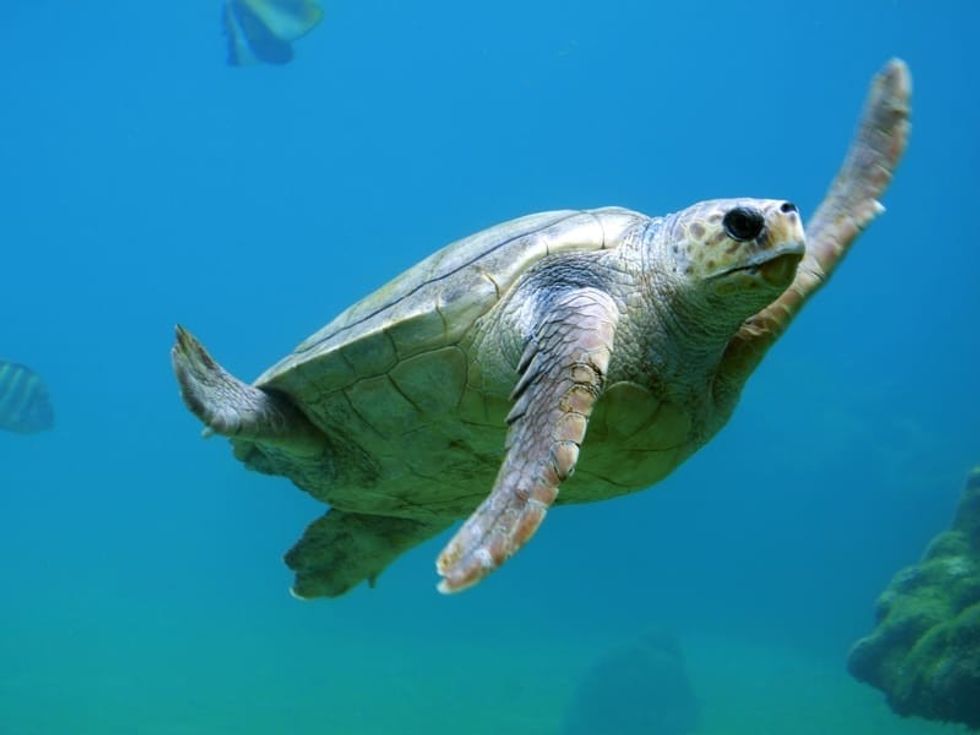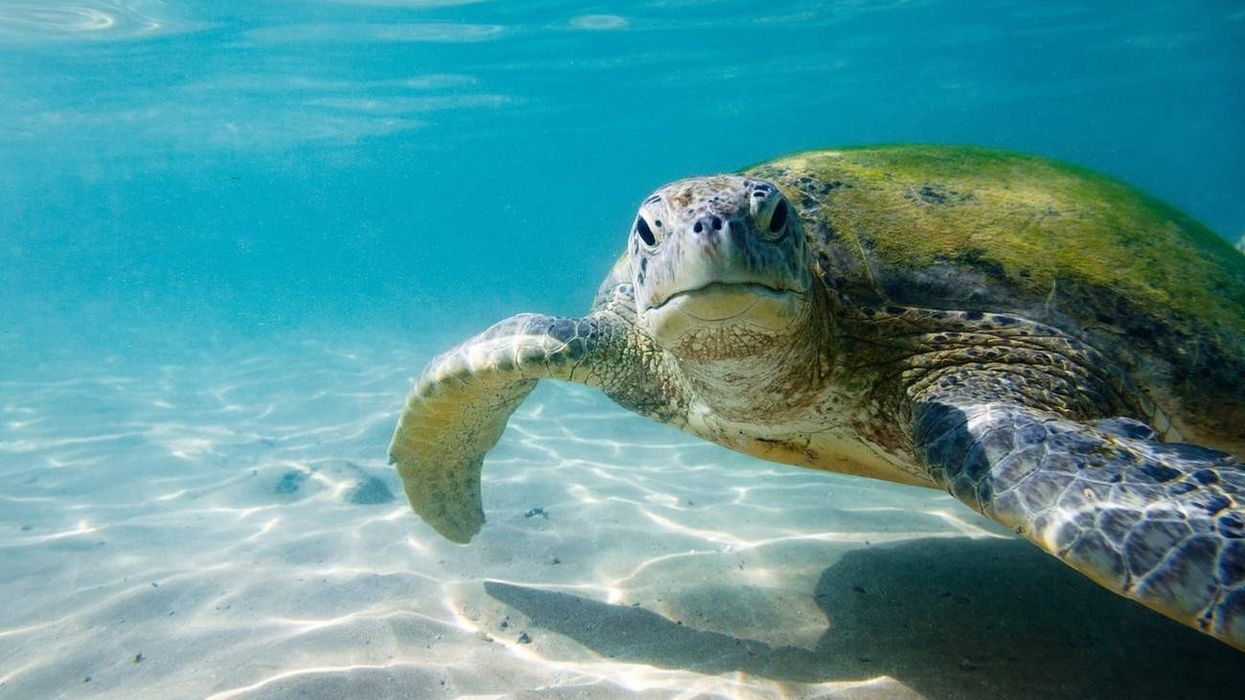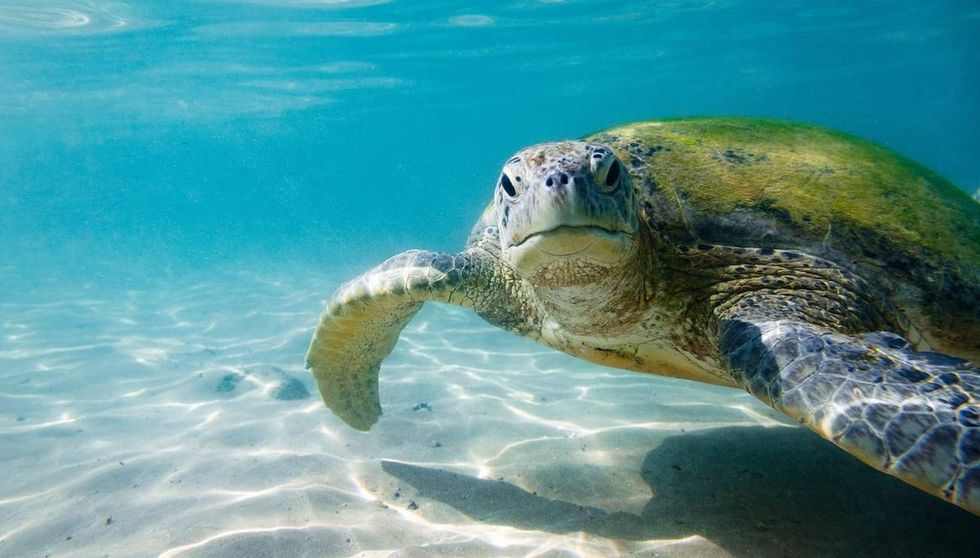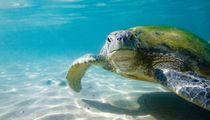Fun Turtle Facts For Kids

Turtles are a species of reptiles from the Chelonia order, and are specifically characterized by the shells on their back which is comprised of a bony or cartilaginous shell which is formed from their ribs. This shell helps keep their soft bodies protected and acts as a shield.
Normally turtles live in fresh water and the sea hence being scientifically named Testudines.
Testudines, coming from both extinct and presently living species can be dated back to the Mid Jurassic age million years ago, making them one of the oldest groups of reptiles preceding that of crocodilians as well as snakes. However, in recent times, there are around 360 known species of turtles amongst which some are critically endangered.
Turtles are also known as ectotherms meaning cold-blooded, which is a trait common amongst reptiles. Their inner temperatures are subject to change as per the surroundings of their environment.
Leatherback sea turtles, however, have a higher body temperature than the water in which it swims. A per their classification, turtles are classified as amniotes, like other reptiles, mammals, and birds; they breathe normal air and lay eggs on the surface instead of laying them underwater.
There are many species known to survive in cold climates, tropics and have different growth rates ranging from three months to year-round. There are many turtles who barely even get to see water, thriving on land effortlessly, while most of them live their entire lives in water.
Turtles are also commonly kept as pets because of their beautiful shells and cute quotient. One can give them cute names such as Slowpoke, Tortilla, Crush, and the like.
Sea turtles are the most common turtles of all and play a critical role in maintaining balance in the marine ecosystem.
There are seven different types of sea turtles namely, leatherback turtle which is deemed as the world's largest turtle, loggerhead turtle, green turtle, flatback, hawksbill turtle, Kemp's Ridley, Olive Ridley, and the like, most of which are either endangered or critically threatened.
Turtles are quite different from tortoises, however, and must not be mistaken as the same. Turtles have a more dome-shaped shell while tortoises have a thinner and flatter shell. Here is a list of some of the most interesting turtle facts that kids would love to know about.
If you liked our article on turtles, you can check out other engaging articles like the giant tortoise and the hawksbill sea turtle.
Turtle Interesting Facts
What type of animal are turtles?
Turtles are reptiles from the family of Testudines which are typically characterized by their protective outer shell. The shell on their backs is known as the carapace and at the bottom is called the plastron.
They cannot survive without their shells or voluntarily remove them either. They are reptiles known to not only inhabit the land but also spend most of their lives at sea. They however lay their eggs on the surface just like most other reptilians.
What class of animal do turtles belong to?
Turtles belong to the reptilian class of animals and are also deemed as one of the oldest living reptiles, preceding even that of crocodiles and snakes.
How many turtles are there in the world?
The number of turtles in the world is prolific. In fact, there are 360 different variants of turtles as well. However, certain species of sea turtles have been deemed as critically endangered or threatened due to various factors like devastating climate change, humans, and various other factors.
Where do turtles live?
Turtles are found all around the globe especially in North America and Southern Asia. They can be found in different places without swimming in the water and can survive with ease especially on sandy beaches.
What is a turtle's habitat?
Turtles are usually found near coastal areas, close to their aquatic environments and the ocean, in which they spend most of their life living and hunting for food to eat. They can hold air in their lungs for 45 minutes to an hour, and therefore constantly need to come up to the surface for air.
The female turtles even stay on the sand close to the ocean during mating season to lay eggs since they do not lay eggs in the water like other reptiles.
Who do turtles live with?
Normally, sea turtles are very solitary animals and like to live and hunt for food alone and avoid living in groups. However, they are known to interact with other turtles during the mating season.
How long do turtles live?
Turtles are known to have a lifespan of 10 to 150 years in wildlife. Pet turtles can live to the age of 80 and other wild turtles can even live up to be 100 years of age.
The longest recorded age of a turtle is 187 years which is the age of an Aldabra giant tortoise. He is named Jonathan and is known as the oldest living creature in the world.
How do they reproduce?
Turtles are known to be highly solitary animals in the wild. However, they do communicate with each other during mating season.
Females can mate with more than one male. The females store the male's sperm for a while and start nesting at the beach in a nest they made.
Mother turtles usually come up to the surface on the beach in the nesting sites when they need to lay eggs. After mating season, the females lay their eggs three to six weeks after they mate with each other.
The mother turtle digs a nest while using her hind legs to deposit the eggs when she is ready near the ocean. Turtles usually lay around 100 eggs at a time.
Bigger variants of females are known to lay bigger-sized eggs. Since a turtle's life is so solitary, once the female has laid her eggs on the beaches making them nest close to the ocean, she leaves the hatchlings alone to hatch and fend for themselves.
What is their conservation status?
Climate change has a major impact on the turtles which has led to most of the sea turtle species being endangered. Drastic climate change greatly affects nesting sites because it elevates the temperatures of the sand on the beaches.
This in turn affects the sex of turtle hatchlings. This has led to most of the sea turtle species being classified as endangered.
Turtles Fun Facts
What do turtles look like?

Turtles are characterized by their distinguishing shells which are developed from their ribs and their retractable bodies. Their upper shell is known as the carapace and the lower shell is called the plastron.
These two parts of the shell are attached with two bridges at their sides.
They cannot live without their shell. Their size varies from large to small with the smallest being freshwater turtles which are normally small in size.
The largest turtle is the leatherback sea turtle that can reach a length of 6.6 ft (200 cm) and over 2,000 lb (900 kg). There are many turtles known to live on land and therefore their eyes are located to help them look down at objects before them.
A number of aquatic turtles have their eyes towards the top of the head to help them escape predators.
Turtles also have stiff beaks and strong jaws to help them chew but have no teeth. The hawksbill turtle especially is named so for this feature of the shape of the turtles' face.
Herbivorous turtles have serrated-edged ridges that help them cut through tough plants. The outer layer of the shell and their bodies are enveloped with horny scales which are called scutes which are made of the fibrous protein, keratin.
The majority of the turtle population has dome-shaped shells with a few exceptions such as the African pancake tortoise, which is known to have flat, flexible shells.
A turtle's shell comes in a variety of colors with the common colors being black, brown, or olive green. Various others come in orange, red, yellow, or grey markings with, lines, spots, or uneven blemishes.
How cute are they?
Common types of turtles such as freshwater, pond turtles, small turtles, soft-shell turtles, mud turtles which usually come in small compact sizes are exceptionally cute with the baby turtles and hatchlings being outrageously adorable.
Baby sea turtles, green sea turtles are beautiful to look at. However, the large leatherback turtles, Galapagos turtles, or snapping turtles, despite being mammoth-sized and intimidating to look at, are beautiful creatures to look at especially when they are in their own natural habitats.
Eastern box turtles are the most beautiful with their yellow bodies and shells.
How do they communicate?
All turtles are known to be exceptionally solitary creatures and do not generally need to communicate much. However, they do communicate with a sound which is their only mode of communication. Some species of turtles, like male Travancore turtles, make high-frequency whines while mating, and the big-headed freshwater turtle make roaring sounds to deter predators and attackers.
How big are turtles?
Turtles are found all around the world and the size of turtles depends on what species of turtles are in consideration. The smallest freshwater species that live in most areas of the world can range from being as small as 4.5 inches to as large as 6 ft long.
How fast can turtles swim?
Most turtle species live in the sea breaking surface occasionally for air. Sea turtles spend most of their time swimming and can swim as fast as 22 mph (35 kph) to hunt for food or escape prey.
The average speed of most species of tortoise ranges between 0.9 (1.4 kph) to 5.8 mph (9.3 kph) when they swim in an aquatic environment.
How much do turtles weigh?
A turtle's weight differs from species to species ranging from 0.2 lb (95 g) with the largest species known as the leatherback turtle weighing up to 660 lb (300 kg).
What are their male and female names of the species?
There is no specific name given to differentiate between the male species and the female species of turtles.
What would you call a baby turtle?
All species of baby turtles are called hatchlings. Hatchlings are called so especially after they hatch from their eggs.
What do they eat?
Turtles are known to be omnivorous and consume a number of foods ranging from grubs, fish, jellyfish, earthworms, snails, insects, and even plants like grasses, flowers, and shrubs and fruits, like berries, watermelon, and even mushrooms. They also consume carrion (decaying flesh) when it's available.
Are they friendly?
Turtles are known to be overtly gentle creatures who are quiet and timid. However, humans should steer clear from larger variants of turtles, because despite being gentle creatures, if provoked, they can seriously cause injury with their strong jaws or even mortally maim. If you see such turtles, it is advisable to admire them afar and not go near.
Would they make a good pet?
Turtles make exceptional pets and are commonly kept in aquariums all around the world. They are known to be one of the most commonly kept pets.
However, even if they are deemed low maintenance, they need to be taken care of and maintained properly to let them grow and help them survive longer. Feeding them proper food also is an integral part of their growth.
Commercial turtle food is widely available including freeze-dried fish, crickets, mealworms, and even fresh fruits which are highly nutritious for turtles.
Did you know...
Turtles are uniquely known for their ability to breathe through their anus, which is called cloacal respiration and is their main source of oxygen when they hibernate.
What is a group of turtles called?
A collection of turtles have several collective nouns. They are most commonly called bale, and also called doe and nest.
How long can sea turtles hold their breath?
Turtles are known to hold their breaths underwater from 45 minutes to one hour approximately.
Here at Kidadl, we have carefully created lots of interesting family-friendly animal facts for everyone to discover! Learn more about some other reptiles including the Olive Ridley sea turtle and the green sea turtle.
You can even occupy yourself at home by drawing one of our turtle coloring pages.
We Want Your Photos!
More for You
Bachelor of Arts specializing in Journalism and Mass Communication, Postgraduate Diploma in Sports Management

Moumita DuttaBachelor of Arts specializing in Journalism and Mass Communication, Postgraduate Diploma in Sports Management
A content writer and editor with a passion for sports, Moumita has honed her skills in producing compelling match reports and stories about sporting heroes. She holds a degree in Journalism and Mass Communication from the Indian Institute of Social Welfare and Business Management, Calcutta University, alongside a postgraduate diploma in Sports Management.
Bachelor of Law

Abdulqudus MojeedBachelor of Law
A versatile professional with a passion for creative writing and technology. Abdulqudus is currently pursuing his Bachelor of Law from the University of Lagos and has experience as a tutor, intern assistant, and volunteer. He possesses strong organizational skills and is a detail-oriented person.
Disclaimer
1) Kidadl is independent and to make our service free to you the reader we are supported by advertising. We hope you love our recommendations for products and services! What we suggest is selected independently by the Kidadl team. If you purchase using the Buy Now button we may earn a small commission. This does not influence our choices. Prices are correct and items are available at the time the article was published but we cannot guarantee that on the time of reading. Please note that Kidadl is a participant in the Amazon Services LLC Associates Program, an affiliate advertising program designed to provide a means for sites to earn advertising fees by advertising and linking to Amazon. We also link to other websites, but are not responsible for their content.
2) At Kidadl, we strive to recommend the very best activities and events. We will always aim to give you accurate information at the date of publication - however, information does change, so it’s important you do your own research, double-check and make the decision that is right for your family. We recognise that not all activities and ideas are appropriate for all children and families or in all circumstances. Our recommended activities are based on age but these are a guide. We recommend that these ideas are used as inspiration, that ideas are undertaken with appropriate adult supervision, and that each adult uses their own discretion and knowledge of their children to consider the safety and suitability. Kidadl cannot accept liability for the execution of these ideas, and parental supervision is advised at all times, as safety is paramount. Anyone using the information provided by Kidadl does so at their own risk and we can not accept liability if things go wrong.
3) Because we are an educational resource, we have quotes and facts about a range of historical and modern figures. We do not endorse the actions of or rhetoric of all the people included in these collections, but we think they are important for growing minds to learn about under the guidance of parents or guardians.







